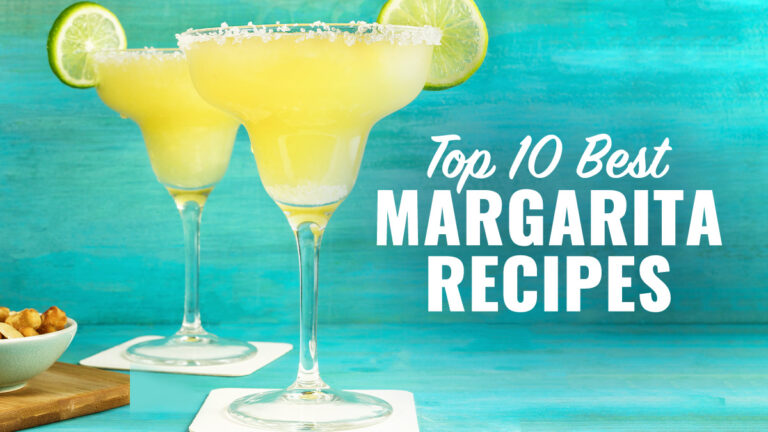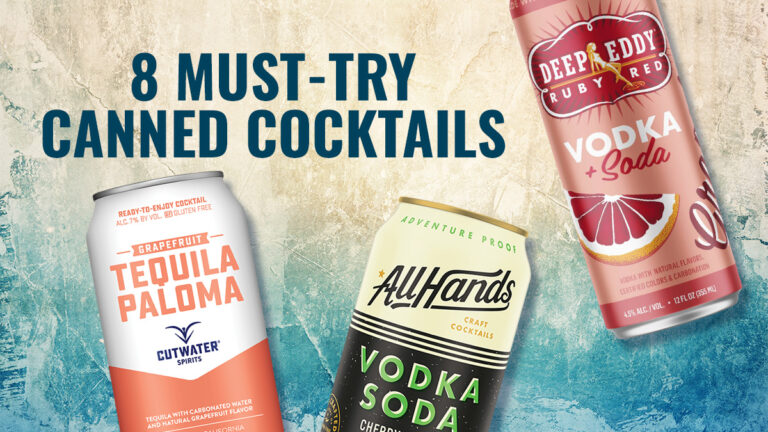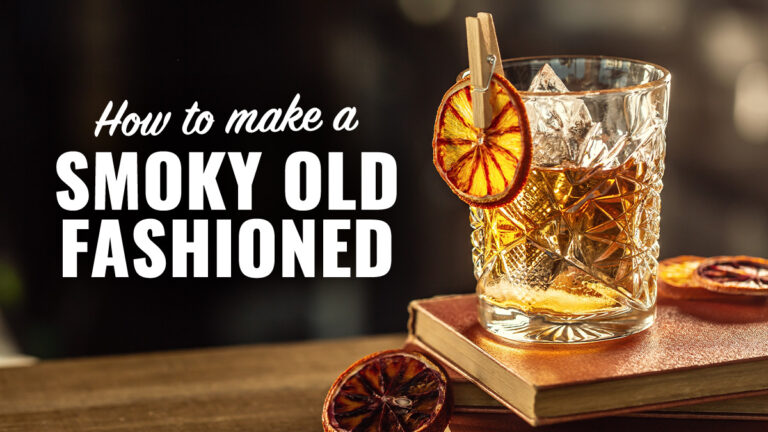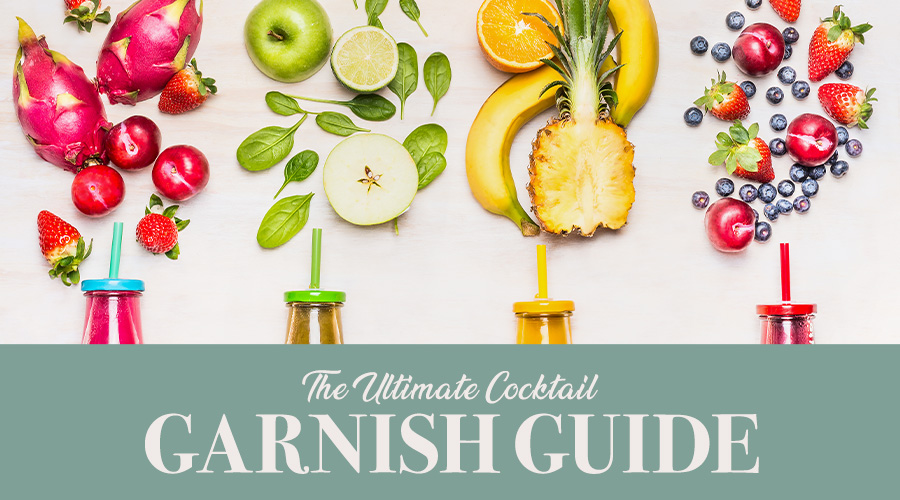
Cocktail Garnishes Guide
Having a snack hanging off your cocktail will not only please your hungry pal, but it will also do wonders for your drink. We’re talking about garnishes, of course!
(Unless there’s some secret glassware grub group we’re not aware of. In which case please let us in!)
At first glance, it might not seem like much, but the way a cocktail is presented to us is a critical component of the drinking experience. And that’s where garnishes come in. Garnishes up the visual appeal as well as introduce aromatics and subtle flavors to cocktails. These small elements can have a big impact on the finished drink, so don’t skimp on them when required or you won’t be getting the full sensory experience! The garnish is the final touch, meant to accentuate the drink’s flavors, tie them together, contrast with them, or perfectly complement them.
Below you’ll find helpful info about garnishes including popular types and when to use them with which cocktail. Just remember it doesn’t have to be fancy to be effective!
Where did the cocktail garnish come from?
Cocktail garnishes have been around for centuries and were originally used for both practical and decorative purposes. Early cocktail recipes often included fruit, herbs, and spices as garnishes, which helped to heighten the flavor and aroma of the drink. Additionally, garnishes were often used to cover up the smell and taste of inferior-quality liquor, making it more palatable for drinkers. Over time, garnishes have become more elaborate and creative, with bartenders using everything from flowers and herbs to candy and bacon to add a unique touch to their cocktails.
What’s the point of cocktail garnishes?
Cocktail garnishes serve several purposes. Firstly, they add visual appeal to the drink, making it look more attractive and appealing to the eye. Secondly, garnishes can enhance the flavor and aroma of the drink, either by providing a complementary or contrasting taste, or by adding an extra layer of complexity to the drink. Finally, garnishes can also be used to convey a sense of style and sophistication, helping to elevate the overall drinking experience.
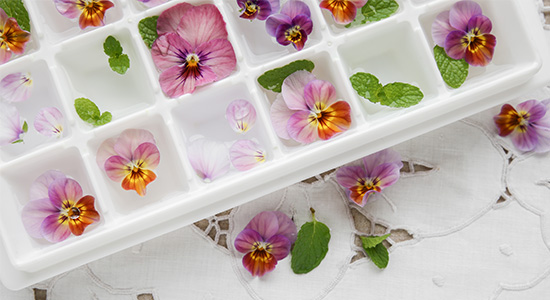
What edible garnishes are there?
There are countless edible garnishes that can be used to boost the flavor and beautify your cocktails. Some popular options include citrus wedges, olives, pickled green beans, cocktail onions, fresh berries, Maraschino cherries, and herbs like mint, basil, and rosemary. Other popular edible garnishes include spices like cinnamon and nutmeg, as well as sweet additions like whipped cream, chocolate shavings, and candy.
Dehydrated fruits are another popular garnish and a great way to save time and money. Unlike fresh ingredients, dehydrated fruits are already sliced and ready to use, which can significantly reduce preparation time, especially when making multiple servings. The most common fruits used for cocktail garnishes include lemons, oranges, pineapples, limes, mangoes, and dragon fruit. Adorning your cocktails with dehydrated fruits can instantly make them look sophisticated and elegant.
What edible flower garnishes are there?
Edible flowers are a beautiful and unique way to garnish cocktails, adding both color and flavor to the drink. Some popular edible flowers for garnishing cocktails include lavender, rose petals, hibiscus, and chamomile. Other options include nasturtiums, violets, and marigolds.
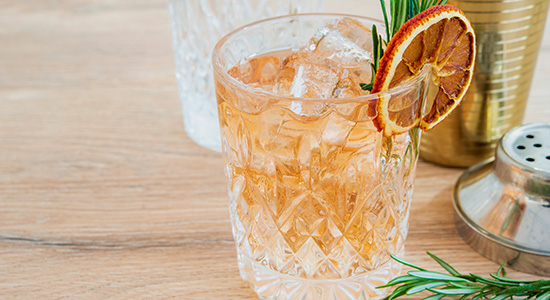
How to choose the best garnish for each drink?
Choosing the right cocktail garnish can be a matter of personal taste, but there are a few guidelines you can follow to help you make the best choice. Firstly, consider the flavor profile of the drink and choose a garnish that complements or contrasts with the flavors in the cocktail. If the garnish doesn’t enhance the flavor of your primary ingredient, then it doesn’t belong on the plate. Secondly, think about the overall style of the drink and choose a garnish that matches the mood and aesthetic of the cocktail. Finally, consider the occasion and the setting in which the drink will be served, and choose a garnish that will add to the overall experience for the drinker.
Below is a simple cocktail garnish list and when to use them.
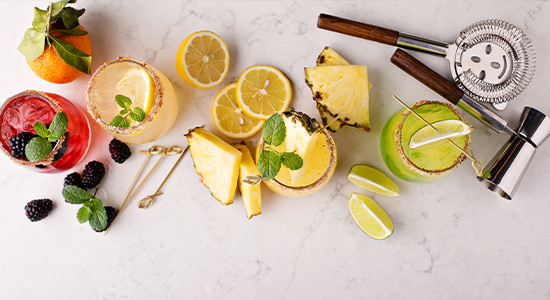
Cocktail Garnishes List
Limes
Limes are used for cocktails such as margaritas, mojitos, gin & tonics, lemon-lime soda-based drinks, and beverages containing sour mix. You can also use a lime garnish to cut the sweetness or spruce up a bland flavor. Many cola-based cocktails, such as a rum and cola, or cranberry juice drinks, use a lime wedge as an accent taste.
Lemon
Lemons typically garnish darker drinks, such as an old fashioned or whiskey sour, but also work well in clear drinks, like some martinis. Lemons are perfect for hard iced teas, cola-based drinks, and lemonade. Lemon peels impart a bitter flavor and are usually found on martinis or similar drinks.
Orange
Unlike lemons and limes, the orange peel is a more popular garnish. You’ll find it used in classic cocktails like a Manhattan, Old Fashioned, or Negroni.
Olives
Only use olives for a straight-up gin or vodka martini.
Cherries
Cherries can add a sweet taste or vibrant look to a variety of cocktails. You’ve probably seen them adoring numerous tropical drinks such as a Mai Tai or piña colada, but you can add them to almost anything. They’re a must-have for many whiskey drinks or anything that uses sour mix.
Table of Contents
Copyright 2023 Spec’s Wines, Spirits & Finer Foods. All rights reserved. This material may not be published, broadcast, rewritten, or redistributed.


